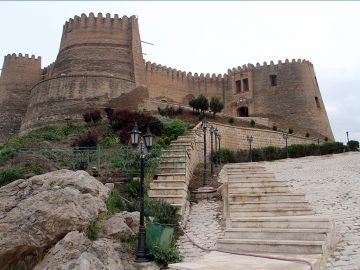
The Falak ol-Aflak Castle located on a hill overlooking Khorramabad City, Lorestan Province dates back to the Sassanid Empire (224-651 CE). The castle has had several names in the course of histories such as Shapour Khast, Siah (Black), Boz, Khorramabad, Sefid (White), Salasel, Atabakan, Ghasr (Palace), Ghale Bala Kushk, and 12-Borj (Twelve-Tower). Of these based on historical documents, Shapour Khast was the oldest name of the castle but as of 1789 since the Qajar Dynasty, the current name, Falak ol-Aflak, has been used.
The castle built mainly with stone, brick, wood, mortar, and lime has an area of 5,200 m2 with a height, considering the hill, accounting for 40 meters. The tallest wall of the castle is also 22.5 meters in height. The Falak ol-Aflak Castle consists of four halls and several rooms surrounding two yards that all of them have a rectangular plan. The entrance to the castle is placed in the north leading to the first yard. Importantly although the structure has had twelve towers in the past, today, eight towers have remained. The water of the castle was supplied from a 40 meter-well behind the first yard.
The Falak ol-Aflak Castle, as a defensive fort, had a significant role in the formation and development of the old city of Khorramabad. Notably, not just as a castle and military fortress, but it had been used as a ruling place, treasury, and even prison in different dynasties. For example, Hasanwayhids, a Kurdish dynasty that ruled over the western part of Iran from about 961 to 1015 used the castle as a ruling place. During the reign of Naser Al-Din Shah, the fourth Qajar king, the castle was rebuilt but at the time of the first king of the Pahlavi Dynasty, Reza Shah was destroyed so as to suppress the powerful local tribes. After the destruction, it was converted to a prison and in 1969, the place turned into a historical attraction open to the public. Finally, since 1975, this structure has been functioning as a museum, first, an anthropology museum and later as of 1977, as an archeology museum.

